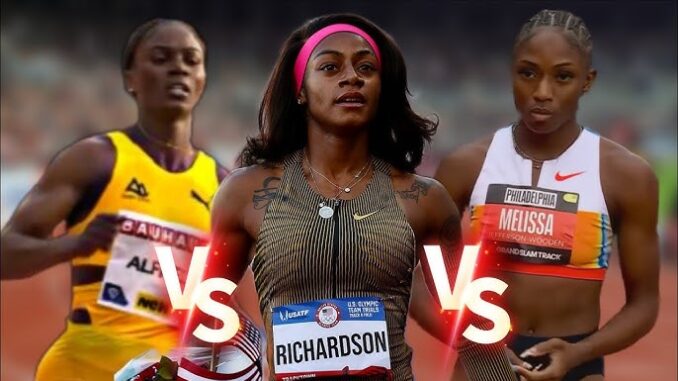
The Women’s 100m at the 2025 World Athletics Championships has opened with drama, promise, and confirmation that the big names are still very much in the picture. In the heats, Julien Alfred and Melissa Jefferson-Wooden established themselves as the sprinters to beat, while Shericka Jackson and Sha’Carri Richardson showed both flashes of form and hints of vulnerability. The early rounds have set the stage for what could be one of the most competitive sprints in recent years.
Alfred was particularly impressive, delivering a crisp performance in her heat, crossing the line in 10.93 seconds, the fastest of the day. Jefferson-Wooden likewise impressed, winning her heat in 10.99 seconds with evident control. Both runners appear confident and physically ready to push through the rounds. On the other side, Sha’Carri Richardson, the defending champion, produced her best time of the season in the heats — 11.03 seconds — but still remains outside the sub-11 barrier she has broken in previous seasons. Shericka Jackson ran 11.04, showing she’s in the mix but perhaps not yet back at her absolute peak.
These times tell us a couple of things. First, Jefferson-Wooden and Alfred are in excellent condition; their heat times suggest that they are holding something back, aiming to peak in the semis and final. Second, Richardson’s sub-optimal start to the season or possible inconsistency in putting together full races means she is under greater pressure: she must find her best early in the competition if she is to defend her world title. Shericka Jackson, likewise, must sharpen her performance to close the gap.
Another dimension is the psychological and strategic advantages. Alfred has momentum: recent wins (including strong Diamond League performances) and the confidence of having beaten some of her chief rivals before. Jefferson-Wooden, unbeaten this season, carries momentum too, but now must navigate through rounds under pressure. Historically, big names like Jackson and Richardson are used to that pressure; but as sprinting becomes more competitive globally, margins are razor thin and any stumble—at the start, in reaction time, or mid-race—can make the difference.
The heats results also suggest that some surprises may be in store. Other sprinters—Tina Clayton among Jamaicans, for example—ran solid times and, while they are not yet being talked of as favorites, have shown possibility. If any of the “favorites” falter, these challengers could rise.
Going forward, these are the key factors to watch:
1. Start and reaction time. In short sprints like the 100m, the first 30-40 metres are crucial. Someone with slower reaction time or poor start can lose ground hard, even if top speed is excellent.
2. Peaking at the right moment. Running heats conservatively is standard, but anyone holding back too much risks not getting the lane, fixture or psychological advantage in the semifinals or final.
3. Maintaining composure under pressure. The championship environment brings distractions: crowd, expectations, past rivalries. How athletes like Richardson or Jackson manage that relative to Alfred or Jefferson-Wooden may tip the balance.
4. Weather, lane assignments and external variables also matter; but given how close the times are, small details may decide.
In conclusion, the initial reaction to the Women’s 100m heats is that Julien Alfred and Melissa Jefferson-Wooden are shaping up as top contenders, while Shericka Jackson and Sha’Carri Richardson have shown enough to suggest they cannot be discounted—but may have to raise their game. The semi-finals and final should make for a thrilling watch, with performance, poise, and strategy likely to define who comes out on top.
Be the first to comment